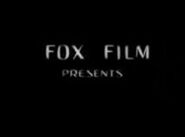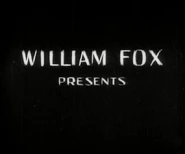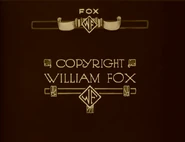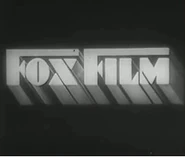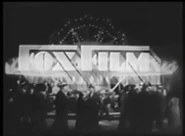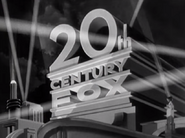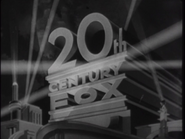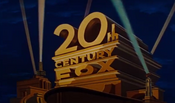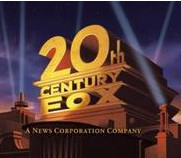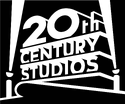Fox Film Corporation
Background: The Fox Film Corporation was an independent film production company that was formed in 1915 by the theater "chain" pioneer William Fox. Fox formed Fox Film Corporation by merging two companies he had established in 1913: Greater New York Film Rental, a distribution firm, which was part of the independents; and Fox (or "Box", depending on the source) Office Attractions Company, a production company.
After the Wall Street crash of 1929, William Fox lost control of the company in 1930, during a hostile takeover. Under new president Sidney Kent, the new owners merged the company with Twentieth Century Pictures, Inc. to form 20th Century-Fox in 1935.
1st Logo
(September 13, 1915-November 28, 1935)
Logo: Here is the in-credit text of Fox Films. It would just say:
FOX FILM
PRESENTS
In other cases, it mentioned the name of William Fox:
WILLIAM FOX
PRESENTS
FX/SFX: Just a simple fade in and out.
Music and Sounds: Silent, or the film's opening.
Availability: Very rare. About 75% of Fox Film's pre-1930 feature film output was completely lost in a 1937 vault fire. Can be seen on Sunrise (1927) and other films of the era, but most just a contain a "Fox Films" notice in the credits sequences. Occasionally appears on films shown on TCM's Silent Sunday Nights or on Fox Movie Channel, but showings on the latter have been scarce to none. The logo premiered on Regeneration and made its final appearance on In Old Kentucky.
2nd Logo
(1915-1917)
Logo: We see the word "COPYRIGHT" in a slightly curly serif font with two shapes on either side to make it look like a ribbon or banner, below that we see "WILLIAM FOX" in the same font but larger letters, below that we see an abstract "T" like shape with a diamond and the letters "WF" in a diamond shape.
FX/SFX: The logo appearing, then disappearing.
Music/Sounds: Silent, or the film's opening music.
Availability: Ultra rare, the video above comes from A Tale of Two Cities and it was also seen on Regeneration.
Editor's Note: None.
3rd Logo
(1929?-1933?)
Logo: Over the final frame of a film, we see a long "F" wiping in. Then, "OX" appears letter-by-letter. At this point the background fades into a black screen. Another long "F" wipes in, and "ILM" appears letter-by-letter. A trail appears behind the letters. The entire text is in a weird font.
Variant: A superimposed still version exists.
FX/SFX: The wiping and appearing letters, the changing background.
Music and Sounds: The ending theme to the film.
Availability: Ultra rare. A superimposed version can be seen on Hoopla.
Editor's Note: The first actual logo used for this company. The design resembles the Art Deco design trend of the late 20s-early 30s.
Twentieth Century Pictures, Inc.
Background: Twentieth Century Pictures, Inc. (also known as "20th Century Pictures, Inc.") was an independent Hollywood motion picture production company created in 1932 by Joseph M. Schenck, the former president of United Artists, Darryl F. Zanuck from Warner Bros. Pictures, William Goetz from Fox Film Corporation, and Raymond Griffith. Their material was released theatrically under United Artists.
Twentieth Century Pictures would later merge with Fox Film Corporation, forming 20th Century-Fox in 1935.
(October 7, 1933-April 17, 1936)
Nicknames: "The Searchlights", "Futuristic Structure", "Majestic Tower", "Pre-Fox Structure", "The Jutting 0", "30s Tower", "20th Structure", "20th Century Pictures Structure"
Logo: On a dark sky background, 3 rows of words, "20th", "CENTURY", and "PICTURES, INC.", apparently carved out of stone and/or metal, are seen. The words are "stacked" on top of each other, with similarly carved lines separating the rows. The "20th" is the biggest row, with "CENTURY" and "PICTURES, INC." a bit smaller. A circular stage-like structure juts out from the base of the "stack," with a light below the structure that shines in front of the "stack". There are pedestals on both sides of the stack, each with a non-moving searchlight. In the background, several searchlights scan the sky. This logo was designed by Emil Kosa, Jr. The logo was created as a painting on several layers of glass and animated frame-by-frame.
Alternate Descriptive Video Transcription: Searchlights pierce a starry night sky, sweeping the clouds and illuminating a towering edifice in the form of "20th CENTURY PICTURES, INC."
Closing Title: Superimposed on a special background or sometimes on the last scene of a movie, fade in the words "The End" with fonts that vary on different movies with the following closing texts: "A 20th Century Picture" and below in a smaller font "Released Thru United Artists".
FX/SFX: The searchlights in the background.
Music/Sounds: A marching drum intro leading into a 21-note full orchestra theme that ends with a horn flourish. The fanfare was composed and conducted by Alfred Newman. On some films, the 1st drum roll is cut off due to whatever surviving audio elements were used on the film print.
Music/Sounds Variants: There were a couple of re-recordings of the fanfare that were different than the later re-recording used in the TCF logo. One of the two was used on 1935's Les Misérables and The Call of the Wild.
Availability: Until recently, this logo was on the verge of extinction due to chronic plastering by any of the 20th Century Fox logos. Seen on streaming prints of The Bowery, the Cinema Archives DVD-R of Clive of India, and TV airings of The House of Rothschild along with Blood Money whenever they air on TCM or the Fox Movie Channel Block on FXM. The logo premiered on The Bowery and made its final appearance on Folies Bergère de Paris or The Call of the Wild (1935). Although most prints of The Call of the Wild (1935) have this plastered with the 1953 logo, this has recently resurfaced on the Blu-Ray release (since it uses a new restoration).
Editor's Note: The first appearance of the 20th Century identity, even though it wasn't even Fox and 20th Century Studios yet. If you pay close attention in the background, there are two searchlights that bend, which is considered to be an impossible phenomenon.
20th Century Fox
Background: In 1935, Twentieth Century Pictures, Inc. and Fox Film Corporation merged together to form "Twentieth Century-Fox Film Corporation" (the hyphen between "Century" and "Fox" was dropped in 1985), or simply "20th Century Fox". During the Golden Age of Hollywood it was one of the "Big Five" studios (the other were MGM, Paramount Pictures, RKO Radio Pictures and Warner Bros. Pictures). From 2013-2019, it was a subsidiary of 21st Century Fox Inc., which was a company formed when News Corporation split up into two companies. As of July 2018, their two most financially successful films are Avatar, released in 2009, and Titanic (under international rights), released in 1997. Both films were directed by James Cameron. Fox's most highly acclaimed film, according to review aggregator website Rotten Tomatoes (jointly owned by Universal and Warner Bros.), is All About Eve, released in 1950 and directed by Joseph L. Mankiewicz.
In October 2001, Fox Family Worldwide was sold to Disney for $2.9 billion, giving them control over the channel space as well as the libraries of Saban and TVS. On November 10 of the same year, they renamed it to ABC Family, whose name stuck until it was renamed Freeform in 2016. In December 2017, Disney announced its plans to buy most of 21st Century Fox's assets, which included a bidding war with Comcast; the acquisition process was completed on March 20, 2019, with the last pre-Disney release from the studio being Alita: Battle Angel, released on February 14, 2019. The remaining assets Disney didn't acquire, notably the Fox network and Fox News, were spun-off into a new company called Fox Corporation. On January 17, 2020, Disney announced that it would be dropping the word "Fox" from the company name, presumably to avoid confusion with Fox Corporation, renaming it to "Twentieth Century Studios," along with Searchlight Pictures. However, the studio was still legally incorporated and traded as Twentieth Century Fox Film Corporation until December 4, 2020. On December 4, 2020, the company started using 20th Century Studios, Inc. for the copyright of films and television productions as a Disney subsidiary. On April 7, 2021, Blue Sky Studios (20th Century's longtime animation unit) was shut down, and its assets are now owned by Disney.
1st Logo
(November 8, 1935-May 23, 1968)
Nicknames: "The Searchlights II", "Fox Structure", "Majestic Tower II", "Futuristic Structure II", "20th Structure II", "20th Century Fox Structure", "30s Tower II", "40s Tower", "50s Tower", "60s Tower"
Logo: It's the same as the 20th Century Pictures logo, except "FOX" appears in place of "PICTURES, INC." This logo was once again designed by Emil Kosa, Jr.
Alternate Descriptive Video Transcription: Searchlights pierce a starry night sky, sweeping the clouds and illuminating a towering edifice in the form of "20th CENTURY FOX."
Variants:
- On the 1942 Technicolor film The Black Swan, the logo is tinted in sepia.
- This logo first appeared in black and white, with a Technicolor version for color films debuting in 1936.
- On colorized prints, depending on how it was colorized, the logo would have different colors.
- The logo would either take place on a day or night sky background.
- One extremely rare variant had a slightly altered version of the tower in the opening credits with "presents", in script, below it. This variant was used for Fox Movietone News newsreels.
- For early color releases (except for The Little Princess), the structure is sepia-toned, the left searchlights are pink, the right searchlights are yellow and blue, the "stack" is blue, the middle searchlights are green, and the sky is dark purple.
- On modern prints of Les Miserables (1935), the logo fades into the NTA logo.
- Starting in 1937, The logo was given an enhanced look with the structure being slightly different, and the searchlights being a little bigger. And also the sky in the background was slightly redone.
Closing Titles: Superimposed on a special background or sometimes on the last scene of a movie, fade in the words "The End" with fonts vary on the movie with the following text: "Released through Twentieth Century-Fox Film Corporation", "Released by Twentieth Century-Fox Film Corporation", "Produced and Released by Twentieth Century-Fox Film Corporation" or "Produced and Distributed by Twentieth Century-Fox Film Corporation".
FX/SFX: The searchlights in the background.
Music/Sounds: A redone variant of the 20th Century Pictures fanfare as composed and conducted by Alfred Newman once again, that has become one of the most famous pieces of music in the world.
Music/Sounds Variants:
- On a few films, such as All About Eve, it is silent or has the film's respective opening theme.
- On some 20th Century Pictures reissues, the original TCP fanfare is heard due to sloppy plastering.
- On The Girl Can't Help It and the Blu-ray (and possibly the DVD) release of Laura, the 1953 fanfare was heard.
- Zorba the Greek, one of the last films to use this logo, use the first half of the 1953 CinemaScope fanfare.
- On the 1994 Studio Classics VHS of Carmen Jones, the 1979 fanfare was heard. This is likely due to a reverse plaster error.
- On Seven Arts TV prints, the full CinemaScope fanfare, with extension, is used (the extension is heard over the Seven Arts logo).
Availability: Very common. It's still saved on just about every 20th Century Fox release, with some exceptions. The color version can be seen on the 2007 DVD release of the 1939 version of The Little Princess (although some public domain prints of the film use the next logo, while other prints use either the black-and-white version or no logo at all) and some colorized prints of Bright Eyes and Heidi, as well as some newer colorized prints of Miracle on 34th Street. The logo premiered on Metropolitan and made its final (official) appearance on Prudence and the Pill, although the next logo premiered on The Robe. Some current releases of films such as The Blue Bird (1940), Leave Her to Heaven, Forever Amber and David and Bathsheba in circulation have this logo plastered over with the next one, but is retained on the Twilight Time Blu-Ray of Leave Her to Heaven. Older television prints of Return of the Fly plaster the next logo with this one, while retaining the CinemaScope fanfare, followed by the Seven Arts Television logo.
Editor's Note: The majestic fanfare and the unique design makes this one of the most iconic logos of all time
2nd Logo
(September 16, 1953-December 11, 1987)
Nicknames: "The Searchlights III", "Fox Structure II", "Majestic Tower III", "Futuristic Structure III", "Slanted Zero", "20th Structure III", "20th Century Fox Structure II", "50s Tower II", "60s Tower II", "70s Tower", "80s Tower"
Logo: A redrawn and more clearer version of the last logo, but the "0" on the top is crooked and two searchlights behind the tower have been removed. This logo was designed by Rocky Longo, who was an artist at Pacific Title and Art Studio, Inc. He also designed the next logo.
Trivia: The extended CinemaScope fanfare has appeared in the two Star Wars 'original score' albums. Many other albums carry this fanfare (albeit rearranged). All of these albums can be found on iTunes. The second episode of The Simpsons 27th season, "Cue Detective", features the Todd-AO "Regular 0" variant when Principal Skinner puts the 1967 version of Doctor Doolittle on for the children at Springfield Elementary. In typical biting-the-hand fashion, all the students shout "boo" when the Fox logo appears.
Variants: The Fox logo has had many renditions over the years. Here are some of them:
- 1953-1967: The CinemaScope logo. The searchlights are slimmed down and the structure is placed in the center of the screen with a dark blue sky surrounding it. The logo fades to "TWENTIETH CENTURY-FOX PRESENTS A CINEMASCOPE PRODUCTION/PICTURE".
- 1956-1967: Large-format (70mm, CinemaScope 55) films used a different Fox structure where the "0" is not slanted. It made its first known appearance on Carousel.
- The one with the regular "0" also had this text: "A CINEMASCOPE PICTURE INTRODUCING (in Carousel)/IN (in The King and I (1956)) CINEMASCOPE 55". In 1961, The King and I was re-released in a 70mm version, called "GRANDEUR 70".
- 1960-1967: For movies that were shot in Todd-AO or Dimension 150, such as Can-Can, Cleopatra (1963) and The Agony and the Ecstasy, the 20th Century Fox logo with the regular "0" appears for five seconds and then fades to the words "TWENTIETH CENTURY-FOX PRESENTS". The Bible: In The Beginning... (1966) contains the text "A TWENTIETH CENTURY-FOX RELEASE" with copyright information below it.
- 1957-1987: Like the slanted zero version of CinemaScope logo, but without the snipe and fades out.
- 1956-1967: Like the standard zero logo, but does not have the snipe and fades out.
- There is an extended version of the 1953-1987 logo without the CinemaScope logo. It appeared only on the Mel Brooks films High Anxiety and History of the World, Part I'.
- 1968-1987: The structure and the sky background are off-center and shifted to the left. Beginning around 1976, the registered trademark symbol "®" was added to the bottom of the logo.
- There was a short version of this logo.
- The logo would take place on either a day or a night sky.
- On older international prints (and a recent TV airing) of Chariots of Fire (released by Warner Bros. Pictures and The Ladd Company in the US) and Breaking Away, the logo is zoomed in, as both films were shot in "open matte" and the logo was not adjusted for widescreen.
- On Quintet, the logo fades to a white snowstorm, revealing the start of the movie.
- An ultra dark variant due to film deterioration exists. Such films that have this variant are older prints of The Omen.
- A still variant made a strange appearance on a Nick@Nite airing of Dr. Dolittle 2 (2001).
Closing Titles:
- 1953-1965: Same as above, but the "The End" words were moved to very top and the 20th Century-Fox text is pushed to the bottom to give space for the text "A CINEMASCOPE PRODUCTION" or "A CINEMASCOPE PICTURE".
FX/SFX: The searchlights in the background.
Music/Sounds:
- November 5, 1953-1960: The 1953 recording of the original fanfare, which debuted on How to Marry a Millionaire.
- April 30, 1954-1967: The original fanfare is extended for CinemaScope, as played by the 20th Century Fox Studio Orchestra and conductor Alfred Newman, and debuted on River of No Return; after CinemaScope was dropped in 1967, the 1935 fanfare is only used from this point on, until it returned on Star Wars in 1977.
- March 9, 1960: A different recording of the original fanfare, as conducted by Nelson Riddle, debuted on Can-Can.
- 1965-October 31, 1981: The 1935 recording of the original fanfare, last heard on Shock Treatment.
- 1979?-December 11, 1987: A re-orchestrated version of the 1935 fanfare. The earliest known film to have used this fanfare is believed to be Scavenger Hunt. This arrangement is used on the next logo.
- May 17, 1980-: A new recording of the fanfare, as played by the London Symphony Orchestra and conductor John Williams, which debuted on (Star Wars: Episode V) The Empire Strikes Back.
- In other cases, it is silent or on some films has the opening music from the movie's score playing.
Music/Sounds Variants:
- The unfinished final project of Marilyn Monroe, Something's Got to Give (1962), has a shorter, slowed-down version of the 1997 fanfare (re-orchestrated a la the 20th Television fanfare). The film can be found as a bonus feature on the special edition DVD of The Seven Year Itch.
- An abridged remix of the 1954 CinemaScope fanfare, beginning with 0:03-0:04 of the fanfare, then 0:05-0:09 and finally 0:18-0:23. This can be heard on quite a few films, such as Brubaker, Fatso, Fire Sale, Willie & Phil, Damien: Omen II, The Stunt Man, the 1973 TV movie Miracle on 34th Street, and the 1980 TV movie The Diary of Anne Frank.
- There is also a slightly modified version of the 1954 CinemaScope extended fanfare. This can be found on Star Wars (later known as Star Wars: Episode IV - A New Hope), released in 1977. It has an echo-like effect and sounds slightly re-orchestrated.
- High Anxiety, also released in 1977, had a slightly modified version of the 1954 CinemaScope fanfare that sounded like a combination of the regular 1954 fanfare and the modified version from Star Wars and is also reverberated (noticeable at the tail end of the fanfare right before the opening credits).
- History of the World, Part I, released in 1981, has a different re-orchestration of the CinemaScope extended fanfare.
- There are low toned versions of the 1935 and 1954 CinemaScope fanfares that exist on some films.
- Older prints of The Call of the Wild (1935) have the 20th Century Pictures fanfare.
- On some current prints of The Two Little Bears, it uses the 1982 fanfare over the CinemaScope variant.
- Recent prints of The Roots of Heaven play the 1994 fanfare over the CinemaScope variant.
- The original 1977 Magnetic Video release of Fantastic Voyage has the opening flourish of the Magnetic Video music mistakenly playback during the first half of the fanfare.
- Netflix prints of French Connection II used an abridged recording of the John Williams 1980 rendition of the CinemaScope extension (1999 orchestration).
- On original theatrical and VHS prints of Revenge of the Nerds, the 1982 fanfare extension was used.
Availability: Very common. It's still retained on just about every 20th Century Fox release, starting with The Robe, the first film to use this logo.
- The CinemaScope variants aren't usually subject to plastering, however one print of Satan Never Sleeps that aired a decade ago on AMC plastered it with the 4th logo, but is retained on DVD releases of said film and a FMC airing.
- Original prints of the first two Star Wars films were also seen with this logo (which are kept on the original theatrical versions on their 2006 DVD), but replaced with the 4th logo on versions from 1997 onward.
- The international version of Chariots of Fire also originally had this logo, but plastered it with the 1994 logo on the 2012 UK DVD release. However, it was intact on a recent TV airing on SKY and the Warner Blu-ray of the international version.
- The original VHS releases of Moving Violation (1976) and Thunder and Lightning by Key Video updated it with the 3rd logo; the former restored it on current prints and the Shout! Factory DVD, while the latter still plasters it but keeps the original abridged fanfare.
- Some releases of Alien and its Director's Cut version plaster it with the 3rd logo, though the first 1981 VHS, 1999 theatrical DVD, and the newest Blu-ray retain it.
- This logo possibly made its final official appearance on Wall Street (as it appeared on the original VHS), though all current prints update it with the 3rd logo. It is unknown if it originally appeared on theatrical prints as well.
- This logo can also be found some early-mid '80s films of the era, such as The Cannonball Run (variant), older video releases of Bill Cosby: Himself (1983), the original CBS/Fox Video release of Revenge of the Nerds (1984), the original Key Video VHS of The Buddy System (1984), Moving Violations (1985), the CBS/Fox VHS of Project X (1987), and older VHS copies of Young Guns II (1990), though the latter film's letterbox LaserDisc release used the third logo. These aforementioned were some of the few films from their respective years to use this logo. Sadly, most home video/DVD releases and TV prints of these films plaster it with the either the 3rd logo or those from another distributor.
- Current prints of Avalanche Express (a Lorimar film they distributed, which WB now owns due to the purchase of the former's library) plaster it with the current WB shield, but is intact on the Spanish R2 DVD.
- Don't expect this logo to appear on Carmen Jones, The Girl Can't Help It, A Circle of Deception, The Longest Day, Zorba the Greek, Those Magnificent Men in Their Flying Machines, Batman: The Movie, The Cape Town Affair, The Day the Fish Came Out, Star!, Deadfall, Prudence and the Pill, Patton (some TV broadcasts spliced in the logo from another film), Tora! Tora! Tora!, Trouble Man, The Poseidon Adventure, US prints of The Towering Inferno (as Fox owns primary North American distribution rights, while Warner Bros. owns most international rights, though both companies worked on the film together), At Long Last Love, The Adventure of Sherlock Holmes' Smarter Brother, Silent Movie and All This and World War II.
- The "regular 0" variant without the CinemaScope snipe or "Twentieth Century-Fox presents" card following is seen on The Sound of Music and the 1967 Doctor Dolittle.
- The 1976 revision makes a very strange appearance on the Criterion Collection Blu-ray of Naked Lunch (a 1991 film).
- Down with Love (2003) uses this logo at the beginning with the News Corporation byline.
- Appears on the Vestron VHS of Fort Apache: The Bronx (despite not mentioning TCF on the cover) and Trifecta's airing of Oh Heavenly Dog!
- Southern Comfort was originally seen with the 1976 revision of this logo before the Cinema Group ident; it can be seen on some older European copies, preceded by the Overseas Filmgroup logo.
- It also plasters the 2009 logo on Logan: Noir Edition.
- This is bizarrely cut from the 1985 Playhouse Video VHS of Escape from the Planet of the Apes, as the Playhouse logo is followed by the film's opening credits. It is also missing from the 1982 Blay Video Laserdisc of Magic, while its VHS counterpart retains it.
Editor's Note: The tilted zero can be an eyesore to look at for some, but it's still a majestic logo.
3rd Logo
(August 28?, 1981-August 5, 1994)
Nicknames: "The Searchlights IV", "Fox Structure III", "Majestic Tower IV", "Futuristic Structure IV", "Pre-Ultra Majestic Tower", "20th Structure IV", "20th Century Fox Structure III", "80s Tower II"
Logo: Another redrawn version of the last logo. This time, the structure is as off-center left as the late 1960s variant of the 1953 logo. This logo was designed when Rocky Longo repainted the eight-layered glass panels, and straightened the zero. This design of the logo still continues to this day (albeit in a slightly modified form).
Variants:
- On some films, such as Porky's Revenge!, the front-left searchlight is pink.
- Some films had the structure looking dark and washed out.
- On widescreen (letterbox) films, the Fox logo would be squeezed to fit on standard 1.33:1 film and then stretched with special projector lenses so it could be shown in widescreen (2.35:1). Though the first two Die Hard films use a version where the logo is not squeezed, and thus is stretched out horizontally.
- On Point Break, the logo starts its animation when it fades in, and then freezes when it's about to fade out.
- On a few films, the logo is in extreme close-up.
- On a couple films, the logo is placed at a very far distance.
- A black & white version of this exists.
Closing Titles: Same as the previous, but the text reads as either: "Produced and Released by Twentieth Century Fox Film Corporation" or "Released by Twentieth Century Fox Film Corporation". In 1990, the text was shortened to either "Released by Twentieth Century Fox" or "Produced and Released by Twentieth Century Fox." On The Abyss, My Cousin Vinny and FernGully: The Last Rainforest, there was a variation which had "RELEASED BY" and below the 20th Century Fox print logo.
FX/SFX: The searchlights in the background.
Music/Sounds:
- August 28, 1981- October 1, 1993: The 1979 fanfare, last heard on Freaked. This was used in tandem with the long version until that year, as most films would either use the long version, have it silent, or the film's opening theme.
- August 6, 1982-July 1, 1994: A re-orchestration of the long version of the 20th Century Fox fanfare, as conducted by Lionel Newman. The first film to use this rendition was The Pirate Movie and the last film to use it was Baby's Day Out.
- In other cases, it was silent, or had the film's opening music play over it.
Music/Sounds Variants:
- On some films, such as The Flamingo Kid and Porky's II: The Next Day, the 1935 fanfare is heard.
- Some prints of pre-1981 films, such as Thunder and Lightning, are plastered with this logo, but keep their original fanfare or sometimes use the 1979 variant. In some cases it is silent, like on Hardly Working, or have the opening theme to the film.
- In 1983, a slightly modified 1980 recording/re-orchestration, as played by the London Symphony Orchestra and conductor John Williams, was used on (Star Wars: Episode VI -) Return of the Jedi. Similarly Class Action & War of the Roses use James Horner's own re-orchestration; some Jerry Goldsmith films also use his own re-orchestration. A strange re-orchestration of the Alfred Newman fanfare with a heavy brass section, as played by the National Philharmonic Orchestra and conductor Charles Gerhardt, was used on The Chase.
- The DVD release of Caravan of Courage: An Ewok Adventure, the French audio track on the 1998 DTS DVD of Predator and a Starz airing of Die Hard 2: Die Harder use the 1997 orchestration.
- On the 1986 remake of The Fly, the abridged remix of the 1954-67 CinemaScope fanfare is surprisingly heard, possibly on purpose.
- On current prints of A Change of Seasons, both the 1935 and 1979 fanfares are played together with this logo. This is likely due to an error when the 1953 logo was plastered over.
- On Wizards, it is out of sync with the 1979 fanfare.
- On current prints of the 1935 Les Miserables, the 20th Century Pictures fanfare is heard (along with the logo being in black & white as the variant mentioned above).
- On Alien 3, the music is re-orchestrated and it ends early, having one of the notes hold unnervingly.
- On AMC's prints of Wall Street, a low pitched version of the 1979 fanfare is heard.
Availability: Very common.
- Notable films to use this logo are Taps, The Verdict, the original theatrical cut of Star Wars: Episode VI - Return of the Jedi (all releases since the 1997 Special Edition plaster it with the next logo, although it is retained on the 2006 DVD release), Porky's II: The Next Day, Porky's Revenge!, Commando, Aliens, Predator, Broadcast News, Big, Die Hard, Predator 2, Home Alone, Die Hard 2, Home Alone 2: Lost in New York, Alien 3, Speed, and Baby's Day Out, among others.
- It allegedly premiered on Chu Chu and the Philly Flash, and appears on VHS copies, but there are theatrical prints in existence with the previous logo. This logo made its final appearance on Airheads, while the next logo debuted on True Lies (which was released three weeks before Airheads).
- Don't expect this to appear on Porky's, The Stone Boy, The Yolk's on You!, The Stone Boy, The Buddy System, Unfaithfully Yours, international prints of Ladyhawke, the trailer for Aliens, Moving Violations, Project X, the original VHS releases of Bill Cosby: Himself and Wall Street, or the UK and Australian VHS releases of Enemy Mine.
- This also plasters the 2nd logo on full frame VHS releases of Star Wars (Episode IV: A New Hope) from 1982 to 1992 (it was retained on the film's HBO premiere in 1983 and widescreen releases of the film on VHS and LaserDisc in 1989, 1992 and 1993; on full-frame prints, the 1995 VHS re-release retains it), the 1988 Key Video VHS of The Undefeated, and current prints of Thunder and Lightning (with the abridged CinemaScope fanfare), Wizards, the Director's Cut of Alien, My Bodyguard (except on the 2016 Kino Lorber Blu-ray, which preserves it), both Revenge of the Nerds films, Bad Medicine, Moving Violations (1985), and Wall Street.
- Fox plastered/updated the 2nd logo with this on some colorized versions of its films in the 1980s, such as Miracle on 34th Street (although its original logo is restored on newer colorized prints), and Technicolor films such as Halls of Montezuma (this plastering carries over to its 2002 DVD).
- This can also be seen on international prints of Crocodile Dundee (and on Australian prints of Crocodile Dundee 2) and Teenage Mutant Ninja Turtles II: The Secret of the Ooze (which surprisingly appeared on a bootleg Blu-ray) & III, as well as the trailer for Deck the Halls.
- When History of the World: Part I (one of the last films to use the 2nd logo) aired on AMC in the mid-2000s, the extended version of this logo popped up at the very end; recent airings on AMC now use the current 20th Television logo instead.
- Post-2007 releases of Die Hard 2 update this with the 1997 logo, while the UK rental VHS of the first movie deletes the logo outright.
- The Hong Kong 1995 P&S LD of Star Wars: Episode VI - Return of the Jedi removes this in favor of CBS-FOX Video.
- The B&W variant is extremely rare, thought it appears on some American prints of The Sicilian (don't expect to see this on the Vestron Video VHS).
- The 1991 (not 1989) Vestron Video release of Young Guns, including the late '90s LIVE reprint which uses that master, plastered the TCF logo with a sped-up silent version of the Vestron Pictures logo, while other prints omit the logo.
- Other Fox releases of Morgan Creek movies have this logo removed on Media Home Entertainment releases and current prints, but is retained on the CBS/Fox Video/Fox Video releases of The Exorcist III, Young Guns II and Pacific Heights and TubiTV's print of Nightbreed (the theatrical cut).
- This was originally seen in front of Largo Entertainment films they distributed theatrically, but most current prints of those films delete the logo entirely after Warner Bros. took over home media distribution.
- Older VHS and DVD copies of Speed have this logo plastered over with the next one; however, it's retained on the 2006 Blu-ray and the 2021 4K Blu-ray.
- IVE's releases, along with DVDs from LIVE Entertainment and Artisan Entertainment (and the 2007 MGM/Fox DVD reissue of The Fabulous Baker Boys), of films from Gladden Entertainment Corporation generally preserved this logo, but it was removed on the 1991 release of Mannequin 2: On the Move by LIVE Home Video, the Blu-ray of Millennium (1989) by Shout! Factory, the Olive Films Blu-ray releases of both Mannequin films, and the 1996 re-release of Weekend at Bernie's by Avid Home Entertainment. It's also preserved on the Vestron Video VHS and Shout! Factory Blu-ray of The Sicilian.
- It is believed that international theatrical prints of Brazil had this logo, but most home video releases go straight to the opening title card while the Fox Blu-rays have the 1994 logo.
- Most U.S. home video releases of The Princess Bride do not have this logo, with the exception of the 1998 MGM VHS, as they only have North American television and theatrical rights and as a result, it can be seen on U.S. TV prints and on the Disney+ print.
- On an 2007 AMC airing of Independence Day (1996), the long version of the logo is seen at the end. The video can be seen here.
Editor's Note: A return to the more accurately drawn Fox tower. This would serve as a template for the next logo below.
4th Logo (July 15, 1994-May 22, 2009, March 30, 2013-June 17, 2014)
Nicknames: "CGI Searchlights", "Ultra-Majestic Tower", "CGI City Skyline Searchlights", "The Searchlights V", "Futuristic Structure V", "Majestic Tower V", "Fox Structure IV", "90s Tower", "2000s Tower", "20th Structure V", "20th Century Fox Structure IV"
Logo: On a black background. two searchlights swoop across the screen, revealing a top aerial view of the 20th Century Fox structure, redone in CGI. The camera pans down and then across the logo, revealing the starry and cloudy blue/purple/orange Los Angeles and Hollywood evening skyline in the distance, before settling into its more customary position and angle. The byline "A NEWS CORPORATION COMPANY" fades in at the bottom of the screen. The structure looks similar to the 1981 logo.
Trivia:
- If one looks very close in the far right-hand corner before approaching the main structure, one can see the Hollywood sign. It is not very big, but it is visible if one looks hard enough. Also, if you look hard enough, you can see stars in the background at the end of the logo.
- This logo was designed by Kevin Burns and animated at Studio Productions (now known as "Flip Your Lid Animation"), who also animated the 1990-1997 Universal logo and the 1986-2003 Paramount logo. The design was used earlier for the 1992 20th Television logo.
- In the 2015 movie Kingsman: The Secret Service, the bylineless version of this logo appears on a news report about the premiere of a fictitious film based upon the film's main villain.
Variants:
- There is a prototype version of this logo where the spotlight shines brighter on the structure.
- On the "Special Edition" remastered versions of the original Star Wars trilogy from 1997 onward and the Star Wars prequel trilogy, there is no camera panning; it just remains in its usual place until it fades to the Lucasfilm Ltd. logo, which is shown over the CinemaScope music extension.
- A short version of this logo appears on The Making of The Pagemaster and the CBS television special I Walk the Line: A Night for Johnny Cash.
- On Fright Night 2: New Blood and Joy Ride 3: Road Kill, the logo is shown without the News Corporation byline due to the split between News Corp and 21st Century Fox.
- On the Disney+ prints of the first six Star Wars movies, the standard Star Wars version is used, but it's bylineless due to the fact News Corporation had spun off into 21st Century Fox which was bought out by The Walt Disney Company.
- Open matte and bylineless versions exist.
Closing Titles:
- Same as recent until 2006.
- On Titanic, the text reads as: "Produced and Released by Twentieth Century Fox and Paramount Pictures".
- At the end of the first two X-Men films and Death Sentence, the print logo is shown.
FX/SFX: The panning of the camera across the Fox structure, the moving searchlights and the News Corporation byline fading in.
Music/Sounds:
- July 15, 1994-January 30, 1998: A re-orchestration of the long TCF fanfare, as conducted by Bruce Broughton in the same stage that the original 1935 fanfare was recorded in. The orchestra is 3 times bigger and the fanfare has more reverberation/echo, and larger brass section and string sections than other TCF fanfares. The first movie to use this fanfare was True Lies and the last movie to use it was Great Expectations. However, Wing Commander (released on March 12, 1999), some prints of Lake Placid 2 (released in 2007), and German productions, such as Krabat (released on October 9, 2008) and John Rabe (released April 2, 2009), used this fanfare instead of the 1997 one.
- November 14, 1997, March 27, 1998-: A slightly slower re-orchestration of the long TCF fanfare, as performed by the 20th Century Fox Studio Orchestra conducted by David Newman, whose father Alfred Newman composed the original fanfare in 1933, as well as its extended counterpart in 1954. It was unveiled during the opening of the new scoring stage, Newman Scoring. The first movie to use this fanfare was Anastasia. After its release, Fox films kept using the 1994 fanfare until January 30, 1998.
Music/Sounds Variants:
- The "Special Edition" version of The Star Wars Trilogy uses the modified 1954 recording of the fanfare as played by the 20th Century Fox Studio Orchestra and conductor Alfred Newman, and the 1980/83 recording of the fanfare as played by the London Symphony Orchestra and conductor John Williams, respectively. Re-orchestrations of John Williams' fanfare were used on the Star Wars prequel films.
- On The Legend of Baggar Vance and most international prints of Braveheart, the opening theme of the movie starts over it.
- On the Australian, New Zealand and UK releases of Shine a Light, it is silent.
- There is a short version of the 1997 fanfare. The only films to use it are The Darjeeling Limited (with the short version of the Fox Searchlight Pictures logo) and Marilyn Monroe's unfinished project Something's Got to Give (1962) with the 2nd logo.
- On some prints of Speed, and the first two Die Hard films, the 1982 fanfare is heard due to plastering of the 3rd logo. Other prints may use the 1994 or 1997 fanfares.
- There is a slightly modified version of the 1994 fanfare. The only film to use it is Turbo: A Power Rangers Movie.
- On Speed 2: Cruise Control, a different re-arrangement of the long TCF fanfare plays.
Availability: Very common.
- It was first seen on the Baby's Day Out trailer, and appears in front of almost every subsequent 20th Century Fox film from True Lies, to its final theatrical appearance being on Tooth Fairy.
- Despite the logo appearing on promotional materials, this doesn't appear at the beginning of Epic Movie or any of its trailers. This is likely a result of the movie's negative reception, in a similar situation to Paramount Pictures and Strange Wilderness. (Perhaps because of this, the trailer for Meet the Spartans doesn't show it as well.)
- Surprisingly, this also appears on some trailers, behind-the-scenes clips and interviews for Predators, as well as the international trailer for Vampires Suck, in tandem with the next logo.
- Also appears on some video games based on 20th Century Fox films.
- This logo was used in tandem with the next logo until mid-2010, and was seen on direct-to-video releases of that year such as Flicka 2, Mirrors 2, and Space Chimps 2: Zartog Strikes Back, among others.
- It plasters the 1953 logo on international DVD releases of Chariots of Fire, where 20th Century Fox holds distribution rights.
- This makes strange re-appearances on Fright Night 2: New Blood, Joy Ride 3: Road Kill, and the Toei Animation production Dragon Ball Z: Battle of Gods (2013), and still remains unchanged on the U.S Funimation DVD and Blu-Ray releases.
- This logo can be spotted on the internationally distributed prints of Street Fighter II: The Animated Movie in some countries, except for the prints in Japan (titled as Street Fighter II: Movie), UK, France and Spain.
- It was also surprisingly preserved on the 2002 US HiT Entertainment DVD release of The Wiggles Movie, where it was re-titled Magical Adventure! A Wiggly Movie. The 2007 reprint from Warner Home Video had it removed.
- It also appears at the beginning of Family Guy: Stewie Griffin: The Untold Story (after a brief prologue and fake trailers created for the film), and is the only Family Guy film to use this logo.
- On digital copies of Star Wars Episodes V-III, the Fox logo is removed and only the Lucasfilm logo (with a custom Star Wars theme) is shown, as this is likely due to Disney's ownership of the latter since 2012.
- Strangely, an international TV spot for Airheads (which can be seen on its 2001 DVD release) contains this logo, while the actual movie (as already mentioned) was the last to use the 3rd logo.
Editor's Note: This is a favorite of many.
5th Logo (July 1, 2009-January 10, 2020, October 23, 2020)
Other nicknames: "CGI Searchlights II", "Ultra Majestic Tower II", "CGI City Skyline Searchlights II", "Enhanced City Skyline Searchlights", "The Searchlights VI", "Majestic Tower VI", "Futuristic Structure VI", "20th Structure VI", "Fox Structure V", "Decade Tower", "2010 Fox", "20th's 75th", "Happy Anniversary, Fox!" "Happy 75th, 20th!", "2010s Tower", "75 Years of 20th Century Fox", "20th Century Fox Structure V", "Great Structure VI", "Semisesquicentennial Tower"
Logo: It's a redone and more realistic version of the 1994 20th Century Fox logo. This time, it is in a dark/orange evening environment. When the structure is in its distance, we can see an extra searchlight and a pair of palm trees on the bottom right hand corner. This structure, like the 1994 structure, also looks similar to the 1981 logo. This logo was designed by Chris Wedge and Carlos Saldanha, and was animated at Blue Sky Studios, 20th Century Fox's sibling company and creator of Ice Age.
Trivia: This logo debuted on a trailer for Avatar on August 20, 2009 for the very first time. Afterwards, the logo first appeared on the aforementioned film, released on December 18, 2009 (though earlier premiering in London on December 10, 2009). Like the previous logo, if one looks very close in the far right-hand corner before approaching the main structure, one can see the Hollywood sign or the radio transmitter (despite not seen in the previous logo). It is still not very big, but it is still visible if one looks hard enough. And still, you can see stars at the end of the logo, but there are fewer than the previous logo. The "Celebrating 75 Years" variant for TCF's 75th anniversary is a well done contemporary throwback of--and a contemporary homage to--the 20th Century Fox CinemaScope logo, where the 20th logo faded after 10 seconds into the CinemaScope logo. Also, a picture of Scrat from the Ice Age franchise can be seen. Surprisingly, this has made an appearance on a season 3 episode of This Is Us.
Bylines:
- December 10, 2009-June 28, 2013: "A NEWS CORPORATION COMPANY"
- July 17, 2013-January 10, 2020, October 23, 2020: Bylineless
Variants:
- During the logo's first official year, 2010, while the logo finishes its move into position, the camera pans up and two streaks of light draw "75" with the word "CELEBRATING" above the numbers and "YEARS" below both in spaced-out letters. The camera pans the words and numbers in position. Also, the Registered trademark symbol "®" and the News Corporation byline are engraved on different parts of the structure.
- The prototype version had a much darker red-orange sunset sky, harder shading, and different searchlight positions.
- The version where the wireframe fades in on the 3D geometry at the end of the logo sequence is part of Dave Strick's environment reel video. The details including his email address is also at the beginning where the logo starts blurry and then gains focus.
- A short version with the final seconds of the animation appears on licensed video games, such as Rio: The Video Game, Aliens vs. Predator, Ice Age: Continental Drift and Aliens: Colonial Marines.
- The final half of this logo's camera-panning sequence can be seen at the beginning of Star Wars Episode I: The Phantom Menace 3D.
- Starting with the release of Turbo on July 17, 2013, the News Corporation byline is excluded and the logo is bylineless for the first time since the 1935 logo. This is mainly due to the aforementioned split on June 28, 2013.
- An enhanced version of this logo was shown exclusively on Blue Sky movies, making the searchlights brighter and the 'X' in 'FOX' brighter, and the structure was given a more-realistic look. It debuted on Ice Age: Collision Course and made its final appearance on Spies in Disguise.
Closing Title: For the most part, none. There are a few closing variants, however:
- A short version without the camera panning is seen at the end of Lincoln, DreamWorks Animation films starting with The Croods and ending with Captain Underpants: The First Epic Movie, and the FOX network airings of Ice Age: A Mammoth Christmas. Surprisingly, it's also seen on The Simpsons short: Maggie Simpson in 'The Longest Daycare, the Home teaser short: Almost Home and the Ice Age: Collision Course announcement short as an opening logo. A bylineless version appears at the end of Ice Age: The Great Egg-scapade and Terminator: Dark Fate.
- At the end of Star Wars: Episode I - The Phantom Menace 3D, the text "Released by Twentieth Century Fox Film Corporation" is shown.
- Like the previous logo, at the end of Parental Guidance and Son of God, the print logo is shown.
FX/SFX: Same as before.
Music/Sounds: The 1997 fanfare, same as the one from the previous logo.
Music/Sound Variants:
- A combination of the 2007 and the 1989 20th Century Fox Television fanfares was heard at the end of Ice Age: A Mammoth Christmas.
- The 1999 recording of the 1980 re-orchestrated fanfare, as conducted by John Williams and played by the London Symphony Orchestra, was retained at the beginning of Star Wars: Episode I - The Phantom Menace 3D when the final half of 20th's current logo animation was seen, followed by the Lucasfilm logo.
- On the 2013 3D Blu-ray release of Predator, the 2009 logo is used to plaster the 1981 logo, but uses the 1982 fanfare.
- On the international 3D release of Titanic and in German productions, such as Klitschko, Ausgerechnet Sibirien and the first two of Rico, Oskar films, the 1994 fanfare was used.
- In rare cases, such as on the US prints of The Monuments Men, the film's opening music plays over the logo.
- Rio 2 has a Samba style of the fanfare, as conducted by John Powell.
- The drum sound also has been changed, but different in album version and in-film version. While in album version, the drum sound also changed to Samba style, but at the in-film version, the drum only speed up but remains its original sound.
- In very rare instances, such as on Bridge of Spies, the logo is silent.
- On Joy, it has the first half of the 1997 fanfare, but ultimately ends with the last note, followed by the opening theme starting over it on the second half.
- The 2012 and the 1989 20th Century Fox Television fanfares combined was heard at the end of Ice Age: The Great Egg-scapade, though it's slightly quieter and has a small amount of echo at the end.
- Sometimes, the fanfare is played on different instruments, depending on the film:
- War for the Planet of the Apes has the fanfare played on jungle drums and a didgeridoo.
- On Bohemian Rhapsody, the fanfare is played on an electric guitar and drums. This version was recorded by Brian May and Roger Taylor, both of rock group Queen.
Availability: Very common.
- First appeared on Avatar, and the trailer for Aliens vs. Predator (PS3/XBOX 360).
- The prototype versions are found on the trailers and TV spots for Avatar, and later appeared on various video games based on 20th Century Fox films.
- This logo with the phrase "Celebrating 75 Years" and an engraved News Corporation byline made its debut on Percy Jackson & the Olympians: The Lightning Thief, released on February 12, 2010, and last appeared on Gulliver's Travels, released on December 25, 2010.
- It also appears in the international releases of Hot Tub Time Machine and The Darkest Hour.
- The last film to use this logo with the News Corporation byline was The Heat, released on June 28, 2013.
- From 2013 to 2018, it was seen at the start of DreamWorks Animation films before the 2010 DreamWorks Animation logo, beginning with The Croods and ending with Captain Underpants: The First Epic Movie.
- This additionally plasters the previous logo on Star Wars: Episode I - The Phantom Menace (3D prints only) and international prints of Titanic since 2012, and the 1981 logo on Predator (3D prints only) since 2013.
- The final film to use this logo prior to the rename of the studio dropping the "Fox" in the name (mostly due to people associating TCF with other Fox properties, most notably Fox News, which is no longer under common ownership with the studio) was Underwater, released on January 10, 2020. However, the Fox logo made a surprise reappearance on The Empty Man, released on October 23, 2020 (copyrighted 2018), despite its trailer and poster using the Studios logo.
- This logo (especially the News Corporation byline and 75th Anniversary variants) may possibly be in danger of being plastered by the "Studios" logo on future prints, due to their visual similarities. The 4K UHD release of Avatar is an example, where this is plastered by the next logo.
- Occasionally, it appears at the end of some international prints of old Warner Bros.-produced Regency titles (which Fox owns as of today), including Under Siege 2: Dark Territory and The Negotiator.
Editor's Note: A suitable successor to 20th Century Fox's original CGI searchlights.
20th Century Studios
Background: In December 2017, Disney announced its plans to buy most of 21st Century Fox's assets, which included a bidding war with Comcast; the acquisition process was completed on March 20, 2019, with the last pre-Disney release from the studio being Alita: Battle Angel, released on February 14, 2019. The remaining assets Disney didn't acquire, notably the Fox network and Fox News, were spun-off into a new company called Fox Corporation. In January 2020, Disney announced that it would be dropping the word "Fox" from the company name, presumably to avoid confusion with Fox Corporation, renaming it to "Twentieth Century Studios," along with Searchlight Pictures. However, the studio was still legally incorporated and traded as 20th Century Fox until June 2020.
(February 21, 2020–present)
Nicknames: "CGI Searchlights III", "Ultra-Majestic Tower III", "CGI City Skyline Searchlights III", "Enhanced City Skyline Searchlights II", "The Searchlights VII", "Majestic Tower VII", "Decade Tower II", "2020s Tower", "Futuristic Structure VII", "20th Structure VII", "Post-Fox Structure", "20th Century Studios Structure", "21st Century Structure II"
Logo: Nearly the same as the 2009 20th Century Fox logo, except "FOX" is replaced with "STUDIOS", and "CENTURY" is taller to accommodate for it. The logo has also been enhanced with more realistic lighting and textures, a different sky backdrop, different palm trees, sleeker looking searchlights, and a larger and more detailed Los Angeles cityscape.
Variants:
- Starting in 2021 with Free Guy, it uses the sky background from the 2009 logo, albeit slightly enhanced.
- Later that year, staring with Vacation Friends (except for Death on the Nile and the 2022 re-release of Avatar), the registered trademark sign was removed.
- A short version appears on home releases.
FX/SFX: Still very nice CGI by Picturemill, based on Blue Sky's design for the last Fox logo.
Music/Sounds: The 1997 TCF fanfare, same as the previous 2 logos.
Music/Sounds Variant: On The Bob's Burger Movie, after the opening drums, the fanfare was synthesized with sounds, representing key moments to the following mystery.
Availability: Current.
- First seen on a TV spot for The Call of the Wild, while the full version of the logo debuted on the film itself.
- Appears on current 20th Century releases such as The New Mutants, Free Guy, Ron's Gone Wrong, The Last Duel, West Side Story (2021), and Avatar: The Way of Water.
- Also plasters the previous logo on the 4K UHD release of the first Avatar.
Editor's Note: It's quite a nice update to the last Fox logo, although it can be somewhat hard trying to get used to the name change. This is in fact that the name pays homage to the original 20th Century Pictures brand from 1933-1936.
| The Walt Disney Studios Walt Disney Studios Motion Pictures | Walt Disney Pictures (Others | Trailer variants | Closing variants | International | Logo Variations) | 20th Century Studios (Others | On-screen logos | Trailer variants | Closing variants | Logo variations) | Lucasfilm Ltd. (Others) | Lucasfilm Animation | Pixar Animation Studios (Others) | Disneynature | Walt Disney Animation Studios | Marvel Studios (Others) | Marvel Knights | Searchlight Pictures (Others | On-screen Logos | Trailer variants | Logo variations) | 20th Century Animation | 20th Digital Studio | Regency Enterprises (20%) (New Regency) Disney Music Group Disney Theatrical Productions Group Walt Disney Television United States broadcast and cable television ABC Owned Television Stations
International channels Disney Junior Disney XD Fox Fox Life Fox Movies/Premium Fox Sports FX National Geographic Other channels Template:Disney India Radio networks Radio stations Disney Parks, Experiences and Products Template:Marvel Walt Disney Direct-to-Consumer and International Disney Streaming Services: BAMTech Media (75%) | Disney Digital Network | ESPN+ | Hulu (67%) (United States and Japan)20 | Disney+ | FX Now (United States) | Fox+ (Asia) | Fox App (Latin America) | Disney+ Hotstar (India) | Star+ (Latin America) Disney Media Distribution Other assets
Sold Inactive Defunct assets Predecessor companies: 21st Century Fox | Capital Cities/ABC Inc. Notes |

